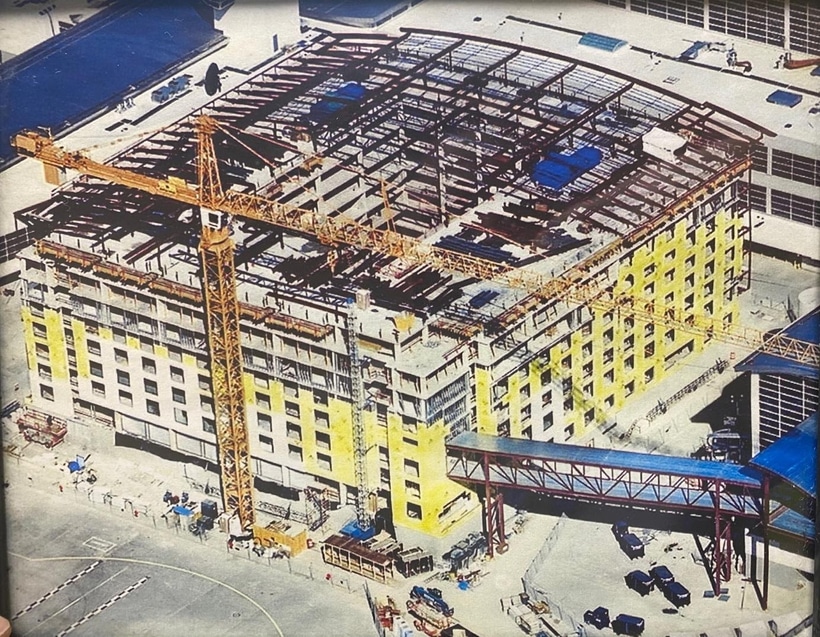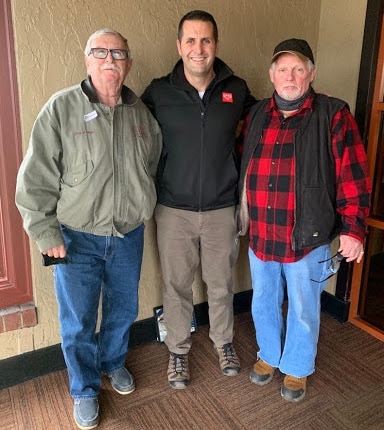
Today, GPRS (Ground Penetrating Radar Systems) is the largest private utility locator in the United States, with a nationwide network of more than 300 project managers in more than 54 major metro areas.
Thanks to our proprietary Subsurface Investigation Methodology (SIM) industry specification, which includes intensive requirements for staff training and on-site processes far exceed the industry standard specifications.
That’s probably a big reason why GPRS has a 99.8% utility strike-free rate, which, again, far exceeds what is standard for private utility locators.
Of course, things weren’t always this way…
In fact, GPRS wouldn’t be what it is today if it weren’t for one fateful decision.
It was Dec. 23, 2001, and I had founded GPRS just over three months earlier. I was on a sales call in Detroit that day. I was driving back home, coming down I-275, and looked over at the airport and saw a tower crane. This was just a few months after 9/11, and there wasn’t a lot of work going on anywhere.
Something inside compelled me to go see what was going on. Between the terminal and the parking garage, there was this square 10-story building. I didn’t know a lot about construction at the time, but it was easy to see this was a post-tension concrete building. I thought, there’s an opportunity here — I had ground penetrating radar in the trunk and maybe this could be a potential job.

Prior to stopping by the job site, I had done one job scanning for post-tension cables. I think I had done three tiny jobs in total in the company’s history. Total revenue billed by GPRS before this was about $4,000. We were not paying the bills. And my patient wife was getting nervous about the idea of GPRS as a business. It was a low point. To be honest, even after this job I continued to wonder if GPRS was a viable business for the first five years of its existence.
Anyway, after driving over to the project to have a look, I did not see any signage indicating what this building was going to be. I just saw it as a 10-story concrete building – one I was hopeful would be in need of ground penetrating radar services.
Driving out of the garage, I did notice a sign for Walbridge Aldinger (now called Walbridge), a contractor based in Detroit. On my way out of the airport, I turned on Eureka Road, and right there at the corner between the access road and I-275 is Trailer City. There were probably 30 or 40 job trailers for all of the contractors working on the terminal.
It was getting dark, and it was late afternoon, probably 5:30 on December 23, 2001. The gate was open, and it looked empty except for one car parked next to a trailer. I thought to myself that was a nice car and maybe its owner had some “say” on this job.
I got out of my car and walked into the Walbridge trailer. I knocked on the door, introduced myself and handed him a brochure (It was our original brochure and I would be embarrassed to hand it out today). He was quiet as he began to look over this little tri-fold and then put it down on his desk. He lifted his index finger and asked, “Are you telling me you can use this to find post-tension cables?”
And I said, “Yeah, it’s one of the main applications for this technology.” He said, “Alright. That hotel (the Westin) has 400 rooms, and I just got a notice from the architect that we have to move all the mechanicals in every room. So we have to drill for shower, tub, toilet flange, the hot and cold water, and sink drain in every single room in that hotel.”
“Plus, we know we are going to have more changes. We’ve already poured all the concrete. It’s a post-tension building,” he continued, and added, “We can’t cut those cables. I’ve never heard of ground penetrating radar, but if you’re telling me that you can do this, that you can mark out the steel on the surface, I can see why we would need this service. But it’s December 23rd. Why don’t you give me a call back after the first year and we can set up a demonstration on how your equipment works.”
At this point, I didn’t realize what an amazing opportunity this was going to be, but in early January, I called the man I met in the trailer on December 23. His name was Gary Wolfe and he was the Project Executive for Walbridge. As we were finishing our conversation he said, “I’m going to set you up a demonstration with some of my superintendents, and if they think you know what you’re doing, we’re going to give you a shot.” One demonstration turned into two, two turned into three. At first it was just marking stuff out. But on the third demonstration, they said, “We’ve got driller here. You mark them, and we’re going to drill them.”
I arrived at the site for the third demonstration. It’s 5 degrees. There were no exterior walls on the building yet. Icy wind is just whipping through it, and… they walk me over to this spot. It’s underneath the pool in the southwest corner of the building. One of the guys said, “All right, we want to drill three holes.”
My heart was racing, I was sweating and praying that they didn’t hit post-tension cable. I wasn’t charging them for the service yet; this was just purely a demonstration of capabilities. I double checked, triple checked, before they started drilling.
And then they drilled all three holes. I knew the concrete was eight inches thick. I watched that coring drill bit go lower and lower into the concrete imagining where eight inches was.
They had a guy down below on the next floor catching the concrete as they finished drillin each hole. He brought up all three core slugs and… drum roll, please… it was nothing but concrete! There was no steel in any of the slugs.
I breathed a huge sigh of relief.
One of the superintendents said, “All right, looks good to me,” he said. “You might want to buy a condo in Romulus, because we’re going to keep you busy for a long time.”
So, my first stop at the site was Dec. 23. The job started right around the first week of February. Every day I would go with the plumbers and mark out all of the reinforcing steel at each location they needed to drill. They’d take me to the bathrooms, in each room. We went room, by room, by room, all around that hotel. I probably got 10 bathrooms done per day. But there was always more work than what was originally intended.
You may be wondering what the alternative to what we offered back then. Well, there was the x-ray, which would’ve set the project back months, even years, if they had to x-ray everything. One of the main reasons for this slow pace was that you couldn’t x-ray unless you had a 50-foot sphere around each shot with no people. So you have to clear out three to four floors below and coordinate your schedule with all 200 to 300 tradesmen on site.
This would have been a nightmare.
Do you want to know the most chilling thing about this story? Every single time that I was on site, from February through October, there was a guard at the gate to the construction trailers. You had to have this little badge hanging from your rearview mirror in your truck to be granted access into the trailer yard.
But back on Dec. 23 at around 5:30 p.m. there was no guard on duty to stop me from going in and checking things out.
Here’s the moral of this whole story: If I didn’t stop right then after driving past the job site, I don’t know if we would’ve gotten the job. And if we didn’t get that job, I don’t know if GPRS would be what it is today.
They ended up drilling well over 2,000 holes in that building. They hit one post-tension cable. It was my fault. The foreman told me “if you would’ve played your odds in Vegas then nobody would be working here. So we’ll take care of getting this one fixed. It’s not on you.”
This is a tremendous story of fate, ambition, and everything just coming together in one moment. But mostly it’s about listening to God’s voice saying “Go check that site out. That could be a great opportunity for you. Make one more stop.”
I should tell you this – in all my sales for the company I’ve never had a stop as good as this one. But it did inspire us to develop the One More Stop mindset.
It’s never just about that first job. This first big job led to many other jobs as this crew was gracious enough to let me use the work I did on this site to create promotional material to hand out on other job sites. These opportunities led to more with Bayview Electric and Pace Mechanical. It even led to another opportunity at Ford Field when it was being built.
I give a ton of credit to that one job. And I give a ton of credit to a few hard-nosed construction guys for giving a 24-year-old kid a chance to try this new technology on this job site to help them solve their problem.
The reason for our One More Stop policy is to keep people as safe as possible.
Our mission is to achieve 100% subsurface damage prevention. We will not stop until there are zero accidents on jobsites everywhere.
I know without a doubt that when you apply this One More Stop mindset to your daily routine, good things will happen no matter what the task in front of you or goal you’re trying to achieve.
You never know if your one more stop could turn into a story like this.

